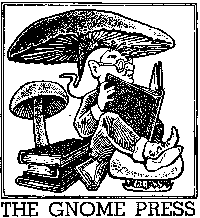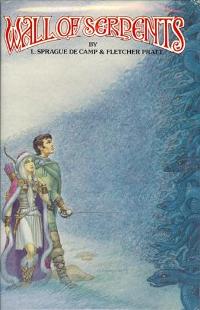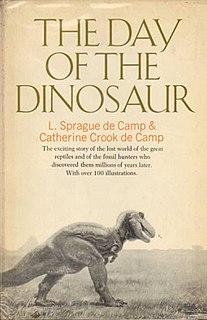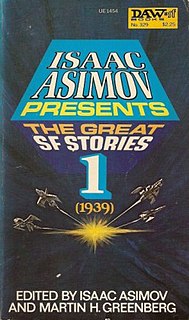
Lyon Sprague de Camp was an American writer of science fiction, fantasy and non-fiction. In a career spanning 60 years, he wrote over 100 books, including novels and works of non-fiction, including biographies of other fantasy authors. He was a major figure in science fiction in the 1930s and 1940s.

Murray Fletcher Pratt was an American writer of history, science fiction, and fantasy. He is best known for his works on naval history and the American Civil War and for fiction written with L. Sprague de Camp.
George H. Scithers was an American science fiction fan, author and editor.
The first Golden Age of Science Fiction, often recognized in the United States as the period from 1938 to 1946, was an era during which the science fiction genre gained wide public attention and many classic science fiction stories were published. In the history of science fiction, the Golden Age follows the "pulp era" of the 1920s and 1930s, and precedes New Wave science fiction of the 1960s and 1970s. The 1950s are a transitional period in this scheme; however, Robert Silverberg, who came of age in the 1950s, saw that decade as the true Golden Age.

John Drury Clark, Ph.D. was an American rocket fuel developer, chemist, and science fiction writer. He was instrumental in the revival of interest in Robert E. Howard's Conan stories and influenced the writing careers of L. Sprague de Camp, Fletcher Pratt, and other authors.

Gnome Press was an American small-press publishing company primarily known for publishing many science fiction classics. Gnome was one of the most eminent of the fan publishers of SF, producing 86 titles in its lifespan — many considered classic works of SF and Fantasy today. Gnome was important in the transitional period between Genre SF as a magazine phenomenon and its arrival in mass-market book publishing, but proved too underfunded to make the leap from fan-based publishing to the professional level. The company existed for just over a decade, ultimately failing due to inability to compete with major publishers who also started to publish science fiction. In its heyday, Gnome published many of the major SF authors, and in some cases, as with Robert E. Howard's Conan series and Isaac Asimov's Foundation series, was responsible for the manner in which their stories were collected into book form.
The Trap Door Spiders are a literary male-only eating, drinking, and arguing society in New York City, with a membership historically composed of notable science fiction personalities. The name is a reference to the reclusive habits of the trapdoor spider, which when it enters its burrow pulls the hatch shut behind it.

NESFA Press is the publishing arm of the New England Science Fiction Association, Inc. The NESFA Press primarily produces three types of books:

Phantasia Press Inc. was an American small publisher formed by Sidney Altus and Alex Berman publishing short-run, hardcover limited editions of science fiction and fantasy books. It was active from 1978 to 1989. The company was based in West Bloomfield, Michigan. The publisher specialized in limited quality first hardcover editions of authors prominent in the field, particularly Philip José Farmer, C. J. Cherryh, L. Sprague de Camp and Alan Dean Foster. Some of its offerings were true first editions; others, the first hardcover editions of works previously published in paperback. In a few instances there had been previous hardcover editions.

Man and Power: the Story of Power from the Pyramids to the Atomic Age is a science book for children by L. Sprague de Camp, illustrated with documents, photographs by Russ Kinne, Roman Vishniac, and others, and paintings by Alton S. Tobey, first published in hardcover by Golden Press in 1961.

The Day of the Dinosaur is a science book by L. Sprague de Camp and Catherine Crook de Camp, illustrated with plates. It was first published in hardcover by Doubleday in 1968, and in paperback by Curtis Books in 1970 or 1971. A second hardcover edition was issued by Bonanza Books in 1985. The first chapter was reprinted as "One Day in the Cretaceous" in the de Camps's collection Footprints on Sand.

The Ancient Engineers is a 1963 science book by L. Sprague de Camp, one of his most popular works. It was first published by Doubleday and has been reprinted numerous times by other publishers. Translations into German and Polish have also been published. Portions of the work had previously appeared as articles in the magazines Fate, Isis and Science Digest.

Footprints on Sand: a Literary Sampler is a 1981 collection of writings by science fiction authors L. Sprague de Camp and Catherine Crook de Camp, illustrated by C. H. Burnett, published by Advent. The collection was compiled to celebrate the de Camps' appearance as joint Guests of Honor at the June 12–14, 1981 X-Con science fiction convention in Milwaukee, Wisconsin and was limited to 1000 copies. An ebook edition was issued by ReAnimus Press in February 2021.

Land of Unreason is a fantasy novel by American writers Fletcher Pratt and L. Sprague de Camp. It was first published in the fantasy magazine Unknown Worlds for October, 1941 as "The Land of Unreason". Revised and expanded, it was first published in book form by Henry Holt and Company in 1942. It has been reprinted numerous times since by various publishers, including by Ballantine Books in January 1970 as the tenth volume of the Ballantine Adult Fantasy series. An E-book edition was published by Gollancz's SF Gateway imprint on September 29, 2011 as part of a general release of de Camp's works in electronic form.

3000 Years of Fantasy and Science Fiction is an anthology of fantasy and science fiction short stories, edited by L. Sprague de Camp and Catherine Crook de Camp. It was first published in both hardcover and paperback by Lothrop Lee & Shepard in 1972. It was the first such anthology assembled by the de Camps, preceding their later Tales Beyond Time (1973).

Isaac Asimov Presents The Great SF Stories 1 (1939) is an American collection of short stories, edited by Isaac Asimov and Martin H. Greenberg, originally published by DAW books in March 1979. It contains science fiction stories selected by the editors that were published in the year 1939. The book is part of a 25 volume series. Each successive volume in the series contains stories from the next year, continuing through 1963. The series starts with 1939 because Asimov had previously published a three volume anthology series titled, "Before the Golden Age", covering years 1931 - 1938, which he considered to be definitive for those years. According to DAW, The Great SF Stories 1 (1939) "is the first in what Isaac Asimov plans to be a definitive series of sf anthologies, covering year by year the truly memorable stories that have progressively brought science fiction to its present prominence". The second volume of the series is Isaac Asimov Presents The Great SF Stories 2 (1940).

Isaac Asimov Presents The Great SF Stories 2 (1940) is an English language anthology of science fiction short stories edited by Isaac Asimov and Martin H. Greenberg. The series attempts to list the great science fiction stories from the Golden Age of Science Fiction. They date the Golden Age as beginning in 1939 and lasting until 1963. The book was later reprinted as the second half of Isaac Asimov Presents The Golden Years of Science Fiction with the first half being Isaac Asimov Presents The Great SF Stories 1 (1939).

"The Gnarly Man" is a science fiction story by American writer L. Sprague de Camp, about an apparently immortal Neanderthal Man surviving into the present day.

Two Complete Science-Adventure Books was an American pulp science fiction magazine, published by Fiction House, which lasted for eleven issues between 1950 and 1954 as a companion to Planet Stories. Each issue carried two novels or long novellas. It was initially intended to carry only reprints, but soon began to publish original stories. Contributors included Isaac Asimov, Robert A. Heinlein, Arthur C. Clarke, Poul Anderson, John Brunner, and James Blish. The magazine folded in 1954, almost at the end of the pulp era.

The Mammoth Book of Classic Science Fiction: Short Novels of the 1930s is a themed anthology of science fiction short works edited by Isaac Asimov, Martin H. Greenberg, and Charles G. Waugh, the first in a series of six samplers of the field from the 1930s through the 1980s. It was first published in trade paperback by Robinson in June 1988. The first American edition was issued in trade paperback by Carroll & Graf in July of the same year. A hardcover edition was issued under the variant title Great Tales of Classic Science Fiction by Galahad Books in May 1990.

















